The ability of thyroid hormone receptors to sense t4 as an agonist depends on receptor isoform and on cellular cofactors
- PMID: 24673558
- PMCID: PMC4004778
- DOI: 10.1210/me.2013-1335
The ability of thyroid hormone receptors to sense t4 as an agonist depends on receptor isoform and on cellular cofactors
Abstract
T4 (3,5,3',5'-tetraiodo-l-thyronine) is classically viewed as a prohormone that must be converted to the T3 (3,5,3'-triiodo-l-thyronine) form for biological activity. We first determined that the ability of reporter genes to respond to T4 and to T3 differed for the different thyroid hormone receptor (TR) isoforms, with TRα1 generally more responsive to T4 than was TRβ1. The response to T4 vs T3 also differed dramatically in different cell types in a manner that could not be attributed to differences in deiodinase activity or in hormone affinity, leading us to examine the role of TR coregulators in this phenomenon. Unexpectedly, several coactivators, such as steroid receptor coactivator-1 (SRC1) and thyroid hormone receptor-associated protein 220 (TRAP220), were recruited to TRα1 nearly equally by T4 as by T3 in vitro, indicating that TRα1 possesses an innate potential to respond efficiently to T4 as an agonist. In contrast, release of corepressors, such as the nuclear receptor coreceptor NCoRω, from TRα1 by T4 was relatively inefficient, requiring considerably higher concentrations of this ligand than did coactivator recruitment. Our results suggest that cells, by altering the repertoire and abundance of corepressors and coactivators expressed, may regulate their ability to respond to T4, raising the possibility that T4 may function directly as a hormone in specific cellular or physiological contexts.
Figures
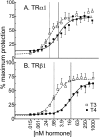
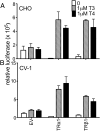
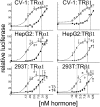


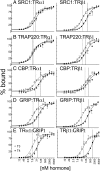
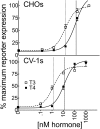


Similar articles
-
Thyroid hormones, t3 and t4, in the brain.Front Endocrinol (Lausanne). 2014 Mar 31;5:40. doi: 10.3389/fendo.2014.00040. eCollection 2014. Front Endocrinol (Lausanne). 2014. PMID: 24744751 Free PMC article. Review.
-
NCoR1 regulates thyroid hormone receptor isoform-dependent adipogenesis.J Mol Endocrinol. 2011 Jun 9;46(3):233-44. doi: 10.1530/JME-10-0163. Print 2011 Jun. J Mol Endocrinol. 2011. PMID: 21389087 Free PMC article.
-
Thyroid receptor ligands. 1. Agonist ligands selective for the thyroid receptor beta1.J Med Chem. 2003 Apr 24;46(9):1580-8. doi: 10.1021/jm021080f. J Med Chem. 2003. PMID: 12699376
-
The two major isoforms of thyroid hormone receptor, TRα1 and TRβ1, preferentially partner with distinct panels of auxiliary proteins.Mol Cell Endocrinol. 2014 Mar 5;383(1-2):80-95. doi: 10.1016/j.mce.2013.11.015. Epub 2013 Dec 8. Mol Cell Endocrinol. 2014. PMID: 24325866
-
Nongenomic actions of thyroid hormone.Nat Rev Endocrinol. 2016 Feb;12(2):111-21. doi: 10.1038/nrendo.2015.205. Epub 2015 Dec 15. Nat Rev Endocrinol. 2016. PMID: 26668118 Review.
Cited by
-
Thyroid hormone signaling specifies cone subtypes in human retinal organoids.Science. 2018 Oct 12;362(6411):eaau6348. doi: 10.1126/science.aau6348. Science. 2018. PMID: 30309916 Free PMC article.
-
Thyroid hormone function in the rat testis.Front Endocrinol (Lausanne). 2014 Nov 5;5:188. doi: 10.3389/fendo.2014.00188. eCollection 2014. Front Endocrinol (Lausanne). 2014. PMID: 25414694 Free PMC article. Review.
-
Thyroxine Induces Acute Relaxation of Rat Skeletal Muscle Arteries via Integrin αvβ3, ERK1/2 and Integrin-Linked Kinase.Front Physiol. 2021 Sep 14;12:726354. doi: 10.3389/fphys.2021.726354. eCollection 2021. Front Physiol. 2021. PMID: 34594239 Free PMC article.
-
Insight Into Molecular Determinants of T3 vs T4 Recognition From Mutations in Thyroid Hormone Receptor α and β.J Clin Endocrinol Metab. 2019 Aug 1;104(8):3491-3500. doi: 10.1210/jc.2018-02794. J Clin Endocrinol Metab. 2019. PMID: 30817817 Free PMC article.
-
Effects of thyroid hormone disruption on the ontogenetic expression of thyroid hormone signaling genes in developing zebrafish (Danio rerio).Gen Comp Endocrinol. 2019 Feb 1;272:20-32. doi: 10.1016/j.ygcen.2018.11.007. Epub 2018 Nov 15. Gen Comp Endocrinol. 2019. PMID: 30448381 Free PMC article.
References
-
- Larsen PR, Davies TF, Schlumberger MJ, Hay ID. Thyroid physiology and diagnostic evaluation of patients with thyroid disorders. In: Larsen PR, Kronenberg HM, Melmed S, Polonsky KS, eds. Williams Textbook of Endocrinology. 10th ed Philadelphia: Saunders; 2003:331–373.
-
- Yen PM. Physiological and molecular basis of thyroid hormone action. Physiol Rev. 2001;81:1097–1142. - PubMed
-
- Flamant F, Baxter JD, Forrest D, et al. International Union of Pharmacology. LIX. The pharmacology and classification of the nuclear receptor superfamily: thyroid hormone receptors. Pharmacol Rev. 2006;58:705–711. - PubMed
-
- Wu Y, Koenig RJ. Gene regulation by thyroid hormone. Trends Endocrinol Metab. 2000;11:207–211. - PubMed
Publication types
MeSH terms
Substances
Grants and funding
LinkOut - more resources
Full Text Sources
Other Literature Sources
Miscellaneous

